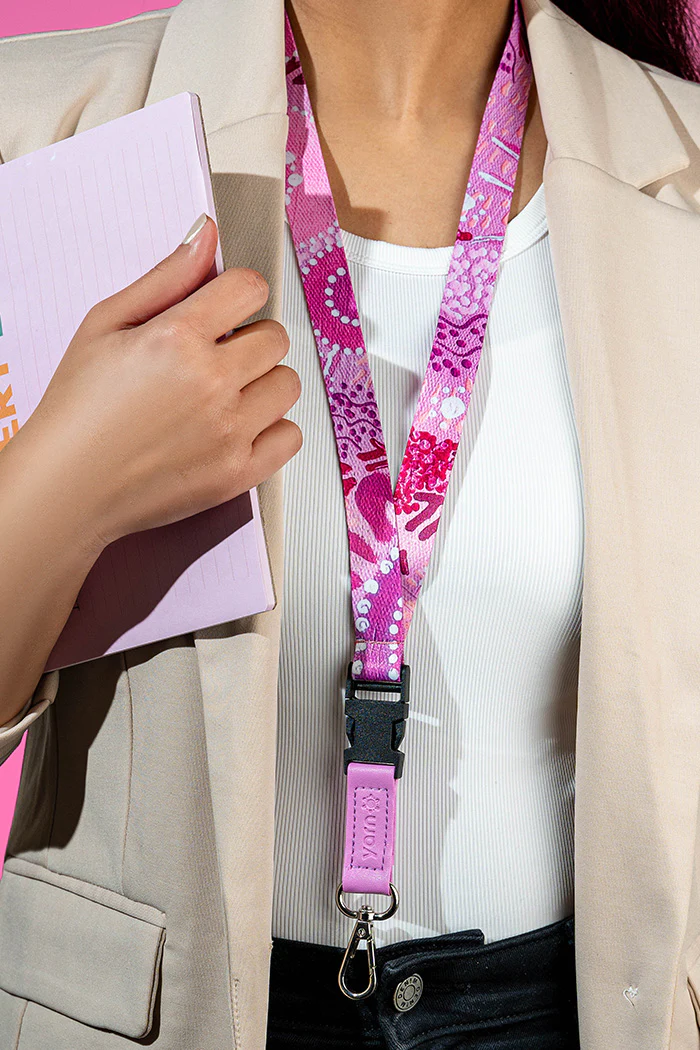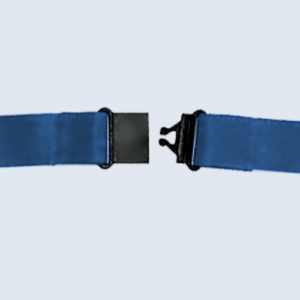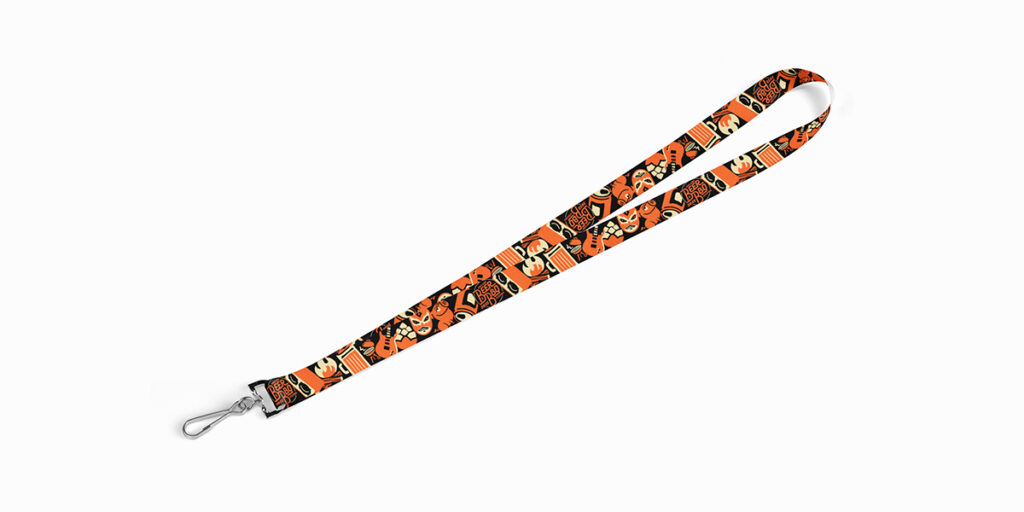EOFY Sale – 20% off sitewide until 30th June – Use code EOFY20 at the checkout
Blog Understanding and Addressing the Safety Concerns of Lanyards

Heat-sublimated lanyards can help the retail and hospitality industry by providing a means of identification, helping hold keys and tools, and being used for marketing purposes.
Whilst in the past there have been some safety concerns regarding lanyards, there are now stringent safety standards such as those set by OSHA (Occupational Safety and Health Administration) and ANSI (American National Standards Institute) that apply to certain types of lanyards.
These safety standards have normalised certain types of lanyards, such as shock-absorbing lanyards, and set the standard for other lanyards, such as breakaway lanyards. These safety features are related to health and safety risks that have been associated with lanyards in the past.
Traditional lanyards, made to hold keys, ID cards and other daily essentials, are commonly designed as a full polyester or nylon loop, and have different coloured and patterned designs.
Shock-absorbing lanyards are stretchable and usually used as part of a fall arrest system. They must adhere to strict safety standards, including OSHA and ANSI Z359, and are used in construction, for example.
Breakaway lanyards are commonly used lanyards that mitigate choking risks. They are made with clasps that open when tugged, and ‘unlock’ the lanyard. These are common not only for their safety, but also because they come with little additional costs to the buyer.
Some lanyards have various built-in safety features that make them safe for people to wear.
Breakaway lanyards, for example, have clasps that open when the lanyard is pulled. This reduced the risk of choking and strangulation when pulled or caught in machinery. Other lanyards, such as retractable lanyards, help to reduce the risk of getting caught on things by pulling in and out as needed.
Breakaway lanyards are the safest lanyard type in most scenarios.
Whereas shock-absorbing lanyards and positioning lanyards are both used in construction, and have various uses within the trades.

A few safety concerns have arisen regarding lanyard use. While they are helpful for carrying ID badges, entry cards, and keys, some potential hazards include strangulation (or choking), entanglement with machinery, and the transmission of bacteria in healthcare.
There are some consequences of neglecting the hazards associated with lanyard use. Lanyards that do not have proper safety features can cause people to be at risk of choking and strangulation, especially if the lanyard is pulled while on someone’s neck. Similarly, if the lanyard gets caught on machinery in the workplace, it can be pulled, posing risks to the safety of workers.
In medical spheres, as well as in the food industry, there are risks of the lanyards swinging from infected surfaces to patients, food or clean spaces, and potentially resulting in the transmission of bacteria and viruses.
Users can effectively mitigate these risks by using breakaway lanyards, following workplace safety protocols, and avoiding using lanyards without breakaways near machinery. In terms of potential infection spread, lanyards should be worn underneath clothing when dealing with food or moving between patients, for example.
Some safety standards require compliance, which is not only an expectation but also a legal requirement.
These standards include those from the OSHA (Occupational Safety and Health Administration) and the ANSI (American National Standards Institute).
These regulations include requirements for the use of positioning and shock-absorbing lanyards for fall prevention, for example. These are mostly for safety lanyards, not for general-use lanyards.
However, it is important to use safety features such as break-away lanyards.
Compliance with these regulations ensures that they protect the health and safety of workers, and can have legal ramifications if they are not abided by.
Whilst there are no formal OSHA or ANSI safety standards specifically for standard lanyards, the workplace should ensure that company-specific safety expectations are met when using standard lanyards. These include investing in breakaway clasps and investing in high-quality lanyards.
Lanyards are used in the construction industry, the healthcare industry, as well as in event management and various outdoor activities. There are unique safety concerns in each industry, such as:
Lanyards are used in these industries to hold ID cards, swipe cards for exclusive entrances, as well as keys and other small items such as information cards.
They are commonly used as they are easy ways to ensure quick identification, and can hold important information, keys and access cards, where they are less likely to be misplaced or stolen.
In each industry, it is important to keep a few key things in mind, in order to make lanyard use as safe as they are helpful.
For example, in all these industries, using breakaway clasps reduces the risk of catching that can cause choking or strangulation. Other practices, such as avoiding wearing lanyards on the outside of clothing, will also reduce the risk of infection spread, catching in machinery, and potential ID card theft in all industries.
There have been many safety innovations when it comes to lanyard design that have helped to mitigate some of these risks.
Some of these innovations include smart lanyards that have RFID tracking, proximity sensors, and even panic buttons. These additional lanyard features help to improve safety in workplaces, helping to manage movements of staff in high-risk areas, as well as aiding in fast identification in emergencies.
As previously mentioned, common safety features include breakaway technology, which involves the use of a small clasp on the lanyard. When pulled forcefully, this clasp opens and releases the lanyard from the wearer’s neck. This reduces the risk of strangulation and choking.
In the future, technology will likely evolve to make lanyards out of antimicrobial materials, which will reduce the risk of infection spread in hospitals and in food industries.

Ensuring accessibility in lanyard design is important because it allows people of all abilities to use lanyards and make the most of what they have to offer. Because lanyards are used in such diverse spheres, including in schools, workplaces and events, it is important that all people can use them safely, regardless of their unique needs.
Inclusive designs that ensure inclusivity include adjustable lengths, easy-to-use clasps, skin-safe material use and availability to add mobility aids.
Adjustable lengths help accommodate people’s different bodies and position different support devices close to the wearer. Easy-to-use clasps ensure that people with limited dexterity or with one hand are able to open and close the clasps easily, for example.
There are various options available for users with disabilities, including tactile identifiers and attachment options for wheelchair users. Other features, such as magnetic break-away clasps, ensure that people with dexterity issues can easily take off and attach lanyards. Disability friendly lanyards make lanyard use easy and accessible for all.
When it comes to cost-benefit analysis and budgeting for safety, there are some cost considerations that should be made.
Some safety features, such as breakaway clasps, will cost slightly more than lanyards without this safety measure. Whilst other materials that may add costs are the use of flame-resistant materials, and accessibility features.
Whilst these add some costs, they come with a massive increase in safety, and reduced financial risk with accidents associated with other lanyard types.
Organisations can effectively budget for safety by assessing risk areas and prioritising high-impact interventions with small costs. For lanyards, this includes investing in breakaway clasps, for example, that are cheap but have a significant increase in safety.
The return on investment for safety measures includes general financial benefits of safety, such as less time off work for employees, and fewer financial ramifications of workplace accidents.
Safety messaging can help enhance marketing efforts by showing a commitment to the health and safety of the customers. It helps put buyers at ease and helps build credibility in the market.
Visual aids can be used to showcase how these safety features can help make lanyards safe and showcase your commitment to keeping buyers safe.
Clear, simple messages and visual aids effectively promote safety features in lanyards and help to boost sales. Highlighting key safety features, such as breakaway clasps and using case studies in marketing campaigns are great ways to promote these features.
Safety-focused branding improves brand reputation by showcasing a real commitment to customer safety. It builds trust in your brand and differentiates you from other brands. These branding strategies can result in a larger customer base with greater customer loyalty.
Whilst investing in lanyards with in-built safety features is one of the best things you can do for accident prevention, and other health and safety risks, it is still important to educate consumers on lanyard safety.
Consumer education is important when it comes to accident prevention and safety awareness. Educating wearers on how to adjust lanyards, when to take them off or wear them under clothing, and how to wear them safely all help increase their safety.
Safety meetings and pamphlets are great tools to use in safety education.
Educating consumers to tighten lanyards in healthcare practices, or when handling food, can help reduce disease transmission, whereas knowing to take lanyards off when using machinery will reduce risks associated with catching on machinery, for example.
Safety awareness helps to prevent accidents, as it raises awareness of the risks associated with lanyard use that have not been addressed.
For example, disease spread is not something that most people think about when they think about lanyard use and associated risks. Raising awareness around these issues will help consumers take responsibility for reducing these risks and help improve safety outcomes.

The main safety concerns when it comes to lanyard use include choking and strangulation risks, as well as the potential for infection spread in healthcare, lab and food industries.
These risks are mitigated by safety features, as well as good consumer education and training. These safety features commonly include break-off clasps, which open the lanyard when tugged, and reduce the risk of choking, for example. Proper consumer education will also reduce the risks of infection transmission by utilising best practice guidelines.
In the future, safety features such as the use of antibacterial materials will help to further reduce the safety risks associated with disease spread.
If you’re interested in lanyards and how they can help you and your business expand, contact us at The Wristband Co. Our lanyards are customisable, offer safety breakaway features, and include ID cardholders. If you are curious about how our lanyards stand out in a crowd, contact us at 08 8363 4850 or [email protected].


Join our mailing list to receive product information, endless inspiration and 10% off your next order!
Monday – Friday 8:30 AM-8:30 PM
Saturday 10:00 AM-5:00 PM
Sunday CLOSED
38 Little Rundle Street Kent Town SA 5067
08 8363 4850
ABN: 62 239 772 879
The Wristband Co. is located on the traditional lands for the Kaurna people, and we respect their spiritual relationship with their Country. We also acknowledge the Kaurna people as the custodians of the Adelaide region and that their cultural and heritage beliefs are still as important to the living Kaurna people today.
Payments Accepted